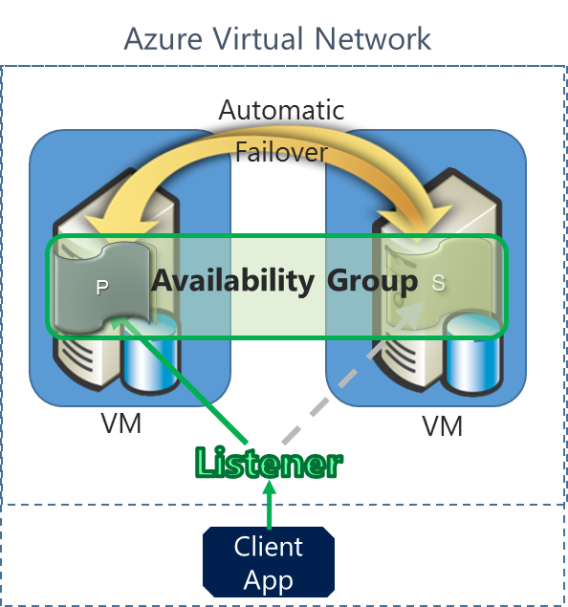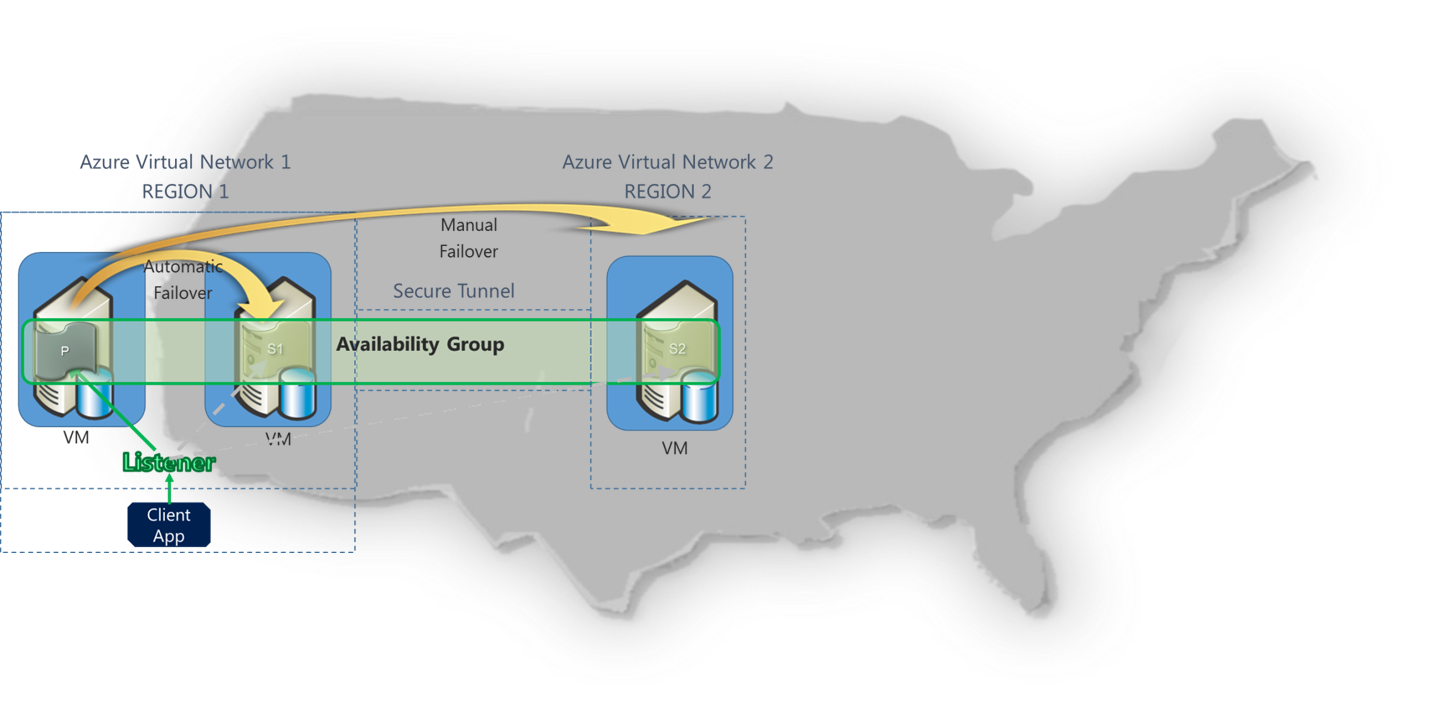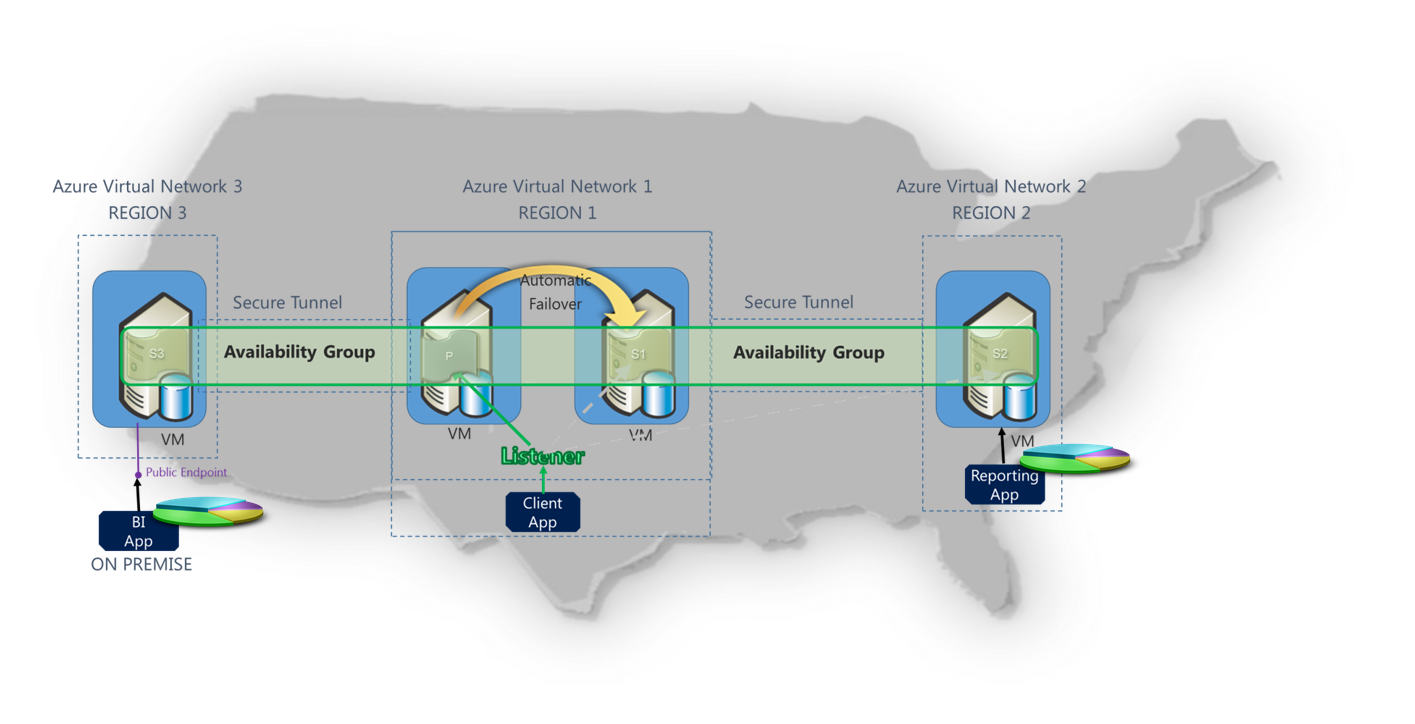SQL Server AlwaysOn Availability Groups Supported between Microsoft Azure Regions
Last year we announced the support of SQL Server AlwaysOn Availability Groups on Microsoft Azure Infrastructure Services.
We’re excited to announce that AlwaysOn Availability Groups are now supported between Microsoft Azure Regions. Today we updated our official documentation describing how to configure these.
AlwaysOn Availability Groups on Microsoft Azure Infrastructure Services
Availability Groups, released in SQL Server 2012 and enhanced in SQL Server 2014, detect conditions impacting SQL Server availability (e.g. SQL service being down or losing connectivity). When detecting these conditions, the Availability Group fails over a group of databases to a secondary replica. In the context of Azure Infrastructure Services, this significantly increases the availability of these databases during Microsoft Azure’s VM Service Healing (e.g. due to physical hardware failures), platform upgrades, or your own patching of the guest OS or SQL Server.
To ensure SQL Server high availability on Azure Infrastructure Services, you configure an Availability Group, generally with 2 replicas (1 primary, 1 secondary) for automatic failover and a Listener. The replicas correspond to SQL Server instances hosted by separate Virtual Machines within the same Azure Virtual Network (VNET). The Listener is a DNS name that client applications, inside or outside the VNET (inside or outside of Microsoft Azure), can use in their connection string to connect to the primary replica of the Availability Group. This is illustrated in the figure below:
AlwaysOn Availability Groups between Microsoft Azure Regions
Availability Groups are now supported between different Azure Regions. Any regions available today (4 in United States, 2 in Europe, 2 in Asia Pacific, 2 in Japan, and 1 in Brazil).
This builds on top of Microsoft Azure’s new support to connect VNETs in different Azure regions via secure tunnels. After connecting 2 or more VNETs, their VMs can connect to each other, and even join the same Windows domain, as if they were part of the same VNET.
Having Availability Groups spanning two or more Azure regions enables two important SQL Server scenarios on Azure Infrastructure Services: disaster recovery and geo-distributed read scale-out.
Scenario 1: SQL Server Disaster Recovery
In this scenario, an Availability Group is expanded with one or more secondary replicas in a different Azure region. This allows quickly recovering SQL Server from a situation impacting a full Azure region (e.g. a gateway hardware failure). This also allows testing disaster recovery processes when desired.
The scenario is depicted in the figure below. An availability group has been configured with 2 replicas (primary P and secondary S1) for automatic failover and a Listener within the virtual network VNET1 in Region 1 (e.g. West US). This guarantees high availability of SQL Server in case of failures within the region. A secure tunnel has been configured between VNET1 and another virtual network VNET2 in Region 2 (e.g. Central US). The availability group has been expanded with a third replica (S2) configured for manual failover in this VNET to enable disaster recovery in case of failures impacting Region1. Finally, the Listener has been configured to route connections to the primary replica, irrespective of which region hosts it. This allows client applications connect to the primary replica, with the same connection string, after failing over between Azure regions.
Scenario 2: SQL Server Geo-Distributed Read Workloads
In this scenario, an Availability Group is expanded with one or more readable secondary replicas in one or more different Azure regions. This allows offloading read workloads from the primary replica to readable secondary replicas in Azure regions that are closer to the source of the read workloads (e.g. reporting or BI apps).
This not only reduces the utilization of resources (CPU, memory, IO) at the primary replica, saving them for write workloads (e.g. OLTP), but also reduces the response time of the read workloads by reducing network latency and leveraging dedicated resources.
The scenario is depicted in the figure below. As before, an Availability Group has been configured with 2 replicas (primary P and secondary S1) for automatic failover and a Listener within the virtual network VNET1 in Region 1 (e.g. Central US). This guarantees high availability of SQL Server in case of failures within the region.
Two secure tunnels have been configured between VNET1 and two other Virtual Networks: VNET2 in Region 2 (e.g. East US) and VNET3 in Region 3 (e.g. West US). The availability group has been expanded with two readable secondary replicas, one on each Azure region: S2 on Region 2 and S3 on Region 3.
Client applications, inside or outside of Azure, can connect to the closest readable secondary replica to run read workloads. For example, a Reporting App connects to the secondary replica S2 within the same Azure Region 2, and BI App connects to the secondary replica S4 from on-premise via a public endpoint.
Remember that the secondary replicas on the remote regions can be failover targets, so they can support disaster recovery besides serving read workloads. In addition, they can be used to take backups, this allows offloading backups from the primary replica to reduce resource utilization, and maintaining backups outside the operational region, if needed for compliance reasons.
Resources






